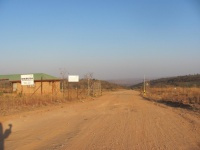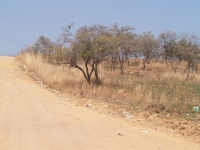

Trip 1: September 2010
On Monday the 7th September I headed east on the N4 from Pretoria for about 50 kilometers, then turned left at Bronkhorstspruit on the R25 and after 65 kilometers arrived at the Mabusa National Park. The route covered in this report is presented in chapter 55 of Birding Gauteng.
A. The Reserve
I was immediately less than thrilled about the reserve when I realised that it is also a major thoroughfare for residents in the area to reach Groblersdal or their settlements (not ideal for a nature reserve) and nothing could have prepared me for the amount of litter, particular beer bottles, that lay all over the place. I found out later that day when I visited the Zithabiseni Resort that they had hosted a festival on the weekend and were busy with a clean up. Still, that did not account for the little strewn some two to three kilometers on either side of their entrance. Here are some pics that I took of the scenery:
Anyway, my rant is over, and now I can get on with my report. I was hoping to see a few lifers on the day, in particular Barrow's Korhaan, Denham's Bustard and Shelley's Francolin. That was not to be successful, so at least I have already had my one failed attempt, so on my next trip I am bound to see them. My theory anyway!
I spent most of my time in the reserve on the main dirt road that passes through the reserve - as the few 4x4 tracks proved to be just a bit too strenuous for my wife's Toyota Avanza. She would have a fit if she knew the roads I was considering driving on! Ignorance is bliss!
It did not take long for a substantial birding list to develop: here is what I saw from the entrance gate to about a kilometer past the offices: Amethyst Sunbird, African Black Duck, Fork-tailed Drongo, Red-chested Swallow (doing the most incredible call that I have heard in the wilds so far), White-bellied Sunbird, Lesser Striped Swallow, Red-billed Hornbill and Swainson's Spurfowl.
I then arrived at the entrance to the Zithabiseni Resort and heard the sound of White-fronted Bee-eater coming from a large tree on the opposite side of the road. This led to some great birding for the next hour or so in which I saw: White-bellied Sunbird, Crested Barbet, Black-headed Oriole, Green Wood-Hoopoe, Dark-capped Bulbul, Southern Black Flycatcher, Lourie, Fork-tailed Drongo, Orange-breasted Bush-Shrike and Southern Boubou.
I then continued down the main dirt road, stopping for a while at the Moses River Bridge (and then I found a track down to the dam close to the tree opposite the resort entrance) where I saw Southern Masked Weaver, Cape Turtle-Dove, Reed Cormorant, Southern Black Tit, Long-billed Crombec and Neddicky.
I spent some time birding in the area around the offices and got to see Southern Black Tit (a mother feeding a worm to her chick - unfortunately the sun was in the wrong position for good pics), Brubru, Black-chested Prinia, Yellow-fronted Canary, Cape Weaver, Southern Masked Weaver, Red-collared Barbet and African Grey Hornbill.
In this area I saw a Cisticola - which I would dearly love to identify as a Red-faced Cisticola which occurs in the area. The lack of rufous colouration on the wings is a good sign... However it has been identified as Rattling Cisticola.
Later in the day, after completing other routes that I will explain in a minute, I visited the Zithabiseni Resort but did not get to see much bird life. The clean up operation was well under way - truly it looked like there was a zillion empty beer bottles on the property. I am glad I did not choose Saturday to bird the "nature reserve". Okay moving on!
B. The Old Verena Road
This dirt road lies 8km south of the entrance to the Mabusa Reserve and is a hotspot for Korhaans. While I did not get to see any, a highlight was seeing a Secretarybird perched high in a tree. I was also lucky to see the bird hunting in the rolling hills on the other side of the road a bit later. A road closed sign a few kilometers down the road was not a good sign, but I was able to complete the whole route without any difficulties. There is a bridge that is somewhat damaged and possibility in the rainy season it could prove difficult to cross. Here are some pics:
A highlight was suddenly realising that a Black-chested Snake-Eagle was perched on a telephone pole not more than 10 meters from my car, but as I switched off the engine it took off - these were the best that I could do while frantically grabbing my camera, opening the window, changing the settings, etc, etc...
The other birds I saw on the route include: Crested Francolin, Swainson's Spurfowl, Hamerkop, Red-billed Quelea, Namaqua Dove, Black-shouldered Kite, Black-crowned Tchagra, Pied Crow, a zillion Speckled Pigeon, White-faced Duck, Southern Red Bishop and Laughing Dove.
I took a few shots of Little Swift in flight:
C. Rietfontein Route
The Old Verena Road finally reaches a tar road that leads into the town of Verena. I then headed off to complete the Rietfontein Circuit - which is a dirt road to the right of the R25 just 700m north of the crossroads in the town. It was a pleasant drive but did not yield a ton of sightings - again, it may have been the time of day (I started the route around 10:30). I did manage to catch a great sight of a Long-tailed Widowbird in transition to breeding plumage, a Common Fiscal giving an aerial display while a Capped Wheatear looked on in amazement, a Pipit that is yet to be identified, African Stonechat, Cape Glossy Starling, Cape Longclaw, Southern Masked Weaver and Burchells Starling.
I then decided to visit Groenfontein Pan and Bronkhorstspruit Dam, but I will post them in separate trip reports as they are covered in different chapters in Birding Gauteng!
Trip 2: August 2011
On Monday the 30th August 2011 I headed back to the Mabusa National Park and focussed my attention on the Old Verena Spa Road. I arrived before the sun was up and immediately heard Shelley's Francolin calling in the hills and headed off on foot down to the river hoping to see and photograph what would be a lifer for me. I got distracted when I saw another lifer that was my target bird for the day - Barrow's Korhaan (previously known as White-bellied Korhaan). No matter what I tried or how low I crept along the ground, I could not get close enough to the 2 birds to get decent shot. They would fly off as soon as they spotted me or felt I was getting too close. Here is the best I could do:
I continued to chase after the Shelley's Francolin - but even though I would head in the direction in which their calls came from, they would stop calling and disappear into thin air. I spent some time birding along the river before returning about an hour later to the main road. The next stop was the little dam on the left hand side of the road along the river. Here are some pics I got at this spot:
A Lark has me mystified. I wondered if it might be Melodious Lark - sadly my pics are not easy to look at and it disappeared before I could observe it's behaviour!
It is always good to see a Lark that is easy to identify thanks to it's call and distinctive features - here are some shots of Rufous-naped Lark that I saw:
And a Pipit that is identifiable is also a good thing. Here is a Buffy Pipit that I managed to photograph:
My next stop was the wetland towards the end of the road - I spent a good 3 hours in this area - even walking down into the dam in the wetland on the north side of the road - the place is well worth exploring as spring arrives!
A Pied Starling allowed me to get really close for some decent shots:
Here is a selection of raptor shots I got on the morning along the route:
Here is a selection of other pics I took along the route:
When I was returning to the main road I spotted 2 Blue Crane at the little dam and tried to get close enough for great pics - but they moved off before I got close enough. They were being harassed by a Blacksmith Lapwing and were not impressed with it!
In total I saw 63 bird species on the morning and got the lifer of the Barrow's Korhaan and came really close to seeing Shelley's Francolin! Here is a full list of all the birds I saw on the Verena Spa Road: African Darter, African Jacana, African Marsh Harrier, African Palm Swift, African Pipit, African Rail, African Snipe, African Stonechat, African Wattled Lapwing, Amethyst Sunbird, Barrow's Korhaan, Black Crake, Black-chested Snake-Eagle, Black-shouldered Kite, Blacksmith Lapwing, Blue Crane, Brown-throated Martin, Burchell's Coucal, Cape Glossy Starling, Cape Longclaw, Cape Turtle Dove, Cape Wagtail, Capped Wheatear, Cattle Egret, Comb Duck, Common Fiscal, Common Moorhen, Common Waxbill, Crowned Lapwing, Dark-capped Bulbul, Egyptian Goose, Greater Double-collared Sunbird, Hadeda Ibis, Helmeted Guineafowl, Laughing Dove, Lesser Swamp Warbler, Levaillant's Cisticola, Lilac-breasted Roller, Little Bittern, Little Grebe, Long-tailed Widowbird, Pied Crow, Pied Starling, Purple Heron, Red-chested Swallow, Red-collared Widowbird, Red-eyed Dove, Red-knobbed Coot, Rufous-naped Lark, Southern Black Flycatcher, Southern Masked Weaver, Southern Pochard, Southern Red Bishop, Speckled Pigeon, Spotted Thick-knee, Spur-winged Goose, Steppe Buzzard, Swainson's Spurfowl, Tawny-flanked Prinia, White-faced Duck, White-throated Swallow, Yellow-billed Duck and Zitting Cisticola.
My next focus for the day was to explore the Mabusa National Park but I arrived around midday which was not ideal and did not have a great time. Here are some shots that I took:
So just under 20 bird species spotted in the hour I spent there including: Tawny-flanked Prinia, Southern Black Flycatcher, Familiar Chat, White-bellied Sunbird, Hamerkop, Southern Masked Weaver, African Wattled Lapwing, Reed Cormorant, Egyptian Goose, Black-headed Oriole, White-fronted Bee-eater, Brown-crowned Tchagra, Green Wood-Hoopoe, Rattling Cisticola, Helmeted Guineafowl, African Grey Hornbill, Cape Glossy Starling, Crested Barbet and Neddicky.
Trip 3: October 2011
I made a brief visit to the reserve hoping to photograph the Flappet Lark that had been seen there the day before - but had to be satisfied with a close up sighting of Fawn-coloured Lark: